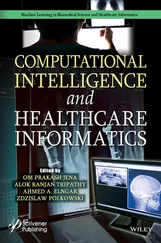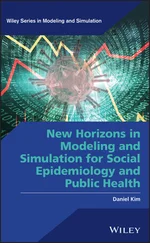Computational Modeling and Simulation Examples in Bioengineering
Здесь есть возможность читать онлайн «Computational Modeling and Simulation Examples in Bioengineering» — ознакомительный отрывок электронной книги совершенно бесплатно, а после прочтения отрывка купить полную версию. В некоторых случаях можно слушать аудио, скачать через торрент в формате fb2 и присутствует краткое содержание. Жанр: unrecognised, на английском языке. Описание произведения, (предисловие) а так же отзывы посетителей доступны на портале библиотеки ЛибКат.
- Название:Computational Modeling and Simulation Examples in Bioengineering
- Автор:
- Жанр:
- Год:неизвестен
- ISBN:нет данных
- Рейтинг книги:3 / 5. Голосов: 1
-
Избранное:Добавить в избранное
- Отзывы:
-
Ваша оценка:
- 60
- 1
- 2
- 3
- 4
- 5
Computational Modeling and Simulation Examples in Bioengineering: краткое содержание, описание и аннотация
Предлагаем к чтению аннотацию, описание, краткое содержание или предисловие (зависит от того, что написал сам автор книги «Computational Modeling and Simulation Examples in Bioengineering»). Если вы не нашли необходимую информацию о книге — напишите в комментариях, мы постараемся отыскать её.
Computational Modeling and Simulation Examples in Bioengineering
Computational Modeling and Simulation Examples in Bioengineering:
Computational Modeling and Simulation Examples in Bioengineering
Computational Modeling and Simulation Examples in Bioengineering — читать онлайн ознакомительный отрывок
Ниже представлен текст книги, разбитый по страницам. Система сохранения места последней прочитанной страницы, позволяет с удобством читать онлайн бесплатно книгу «Computational Modeling and Simulation Examples in Bioengineering», без необходимости каждый раз заново искать на чём Вы остановились. Поставьте закладку, и сможете в любой момент перейти на страницу, на которой закончили чтение.
Интервал:
Закладка:
49 49 Zhang, Y., Barocas, V.H., Berceli, S.A. et al. (2016). Multi‐scale modeling of the cardiovascular system: disease development, progression, and clinical intervention. Ann. Biomed. Eng. 44 (9): 2642–2660.
50 50 Guidoboni, G., Glowinski, R., Cavallini, N. et al. (2009). A kinematically coupled time‐splitting scheme for fluid–structure interaction in blood flow. Appl. Math. Lett. 22 (5): 684–688.
51 51 Guidoboni, G., Glowinski, R., Cavallini, N., and Čanić, S. (2009). Stable loosely‐coupled‐type algorithm for fluid–structure interaction in blood flow. J. Comput. Phys. 228 (18): 6916–6937.
52 52 Bukač, M., Čanić, S., Glowinski, R. et al. (2013). Fluid–structure interaction in blood flow capturing non‐zero longitudinal structure displacement. J. Comput. Phys. 235: 515–541.
53 53 Quarteroni, A. and Formaggia, L. (2004). Mathematical modelling and numerical simulation of the cardiovascular system in modelling of living systems. In: 12 of Handbook of Numerical Analysis, 3–127. Amsterdam: North‐Holland.
54 54 Formaggia, L., Gerbeau, J.F., Nobile, F., and Quarteroni, A. (2001). On the coupling of 3D and 1D Navier–Stokes equations for flow problems in compliant vessels. Comput. Methods Appl. Mech. Eng. 191 (6–7): 561–582.
55 55 Formaggia, L., Lamponi, D., and Quarteroni, A. One‐dimensional models for blood flow in arteries. J. Eng. Math. 47 (3–4): 251–276.
56 56 Nobile, F. and Vergara, C. (2008). An effective fluid–structure interaction formulation for vascular dynamics by generalized Robin conditions. SIAM J. Sci. Comput. 30 (2): 731–763.
57 57 Causin, P., Gerbeau, J.F., and Nobile, F. (2005). Added‐mass effect in the design of partitioned algorithms for fluid–structure problems. Comput. Methods Appl. Mech. Eng. 194 (42–44): 4506–4527.
58 58 Čanić, S., Mikelić, A., and Tambača, J. (2005). A two‐dimensional effective model describing fluid–structure interaction in blood flow: analysis, simulation and experimental validation. Comptes Rendus. 333 (12): 867–883.
59 59 Čanić, S., Tambača, J., Guidoboni, G. et al. (2006). Modeling viscoelastic behavior of arterial walls and their interaction with pulsatile blood flow. SIAM J. Appl. Math. 67 (1): 164–193.
60 60 Čanić, S., Hartley, C.J., Rosenstrauch, D. et al. (2006). Blood flow in compliant arteries: an effective viscoelastic reduced model, numerics, and experimental validation. Ann. Biomed. Eng. 34 (4): 575–575.
61 61 Heil, A., Hazel, L., and Boyle, J. (2008). Solvers for large‐displacement fluid–structure interaction problems: segregated versus monolithic approaches. Comput. Mech. 43 (1): 91–101.
62 62 MacSweeney, S.T.R., Powell, J.T., and Greenhalgh, R.M. (1994). Pathogenesis of abdominal aortic aneurysm. Br. J. Surg. 81: 935–941.
63 63 van't Veer, M., Buth, J., Merkx, M. et al. (2008). Biomechanical properties of abdominal aortic aneurysms assessed by simultaneously measured pressure and volume changes in humans. J. Vasc. Surg. 48 (6): 1401–1407.
64 64 Ganten, M.K., Krautter, U., von Tengg‐Kobligk, H. et al. (2008). Quantification of aortic distensibility in abdominal aortic aneurysm using ecg‐gated multi‐detector computed tomography. Vasc. Intervent. 18 (5): 966–973.
65 65 Molacek, J., Baxa, J., Houdek, K. et al. (2011). Assessment of abdominal aortic aneurysm wall distensibility with electrocardiography‐gated computed tomography. Ann. Vasc. Surg. 25 (8): 1036–1042.
66 66 Di Puccio, F., Celi, S., and Forte, P. (2012). Review of experimental investigations on compressibility of arteries and the introduction of a new apparatus. Exp. Mech. 52 (7): 1–8. https://doi.org/10.1007/s11340‐012‐9614‐4.
67 67 Humphrey, J.D. and Yin, F.C. (1987). A new constitutive formulation for characterizing the mechanical behavior of soft tissues. Biophys. J. 52 (4): 563–570.
68 68 Ogden, R.W. (2009). Anisotropy and nonlinear elasticity in arterial wall mechanics. In: Biomechanical Modelling at the Molecular, Cellular and Tissue Levels. CISM Courses and Lectures, vol. 508 (eds. G.A. Holzapfel, R.W. Ogden, F. Pfeiffer, et al.), 179–258. Vienna: Springer.
69 69 Vande Geest, J.P., Sacks, M.S., and Vorp, D.A. (2004). Age dependency of the biaxial biomechanical behavior of human abdominal aorta. J. Biomech. Eng. 12: 815–822.
70 70 Vande Geest, J.P., Sacks, M.S., and Vorp, D.A. (2006). The effects of aneurysm on the biaxial mechanical behavior of human abdominal aorta. J. Biomech. 39: 1324–1334.
71 71 Koncar, I., Nikolic, D., Pantovic, S. et al. (2013). Modeling of abdominal aortic aneurysm rupture by using bubble inflation test. Bioinform. Bioeng. (BIBE) https://doi.org/10.1109/BIBE.2013.6701612.
72 72 Vande Geest, J.P., Di Martino, E.S., Bohra, A. et al. (2006). A biomechanics‐based rupture potential index for abdominal aortic aneurysm risk assessment. Ann. N. Y. Acad. Sci. 1085: 11–21.
73 73 Thubrikar, M.J., Labrosse, M., Robicsek, F. et al. (2001). Mechanical properties of abdominal aortic aneurysm wall. J. Med. Eng. Techn. 25 (4): 133–142.
74 74 Stamatopoulos, C., Mathioulakis, D.S., Papaharilaou, Y., and Katsamouris, A. (2011). Experimental unsteady flow study in a patientspecific abdominal aortic aneurysm model. Exp. Fluids 50 (6): 1695–1709.
75 75 Holzapfel, G.A. (2006). Determination of material models for arterial walls from uniaxial extension tests and histological structure. J. Theor. Biol. 238 (2): 290–302.
76 76 Simsek, F.G. and Kwon, Y.W. (2015). Investigation of material modeling in fluid–structure interaction analysis of an idealized three layered abdominal aorta: aneurysm initiation and fully developed aneurysms. J. Biol. Phys. 41 (2): 173–201.
77 77 Taghizadeh, H., Tafazzoli‐Shadpour, M., Shadmehr, M., and Fatouraee, N. (2015). Evaluation of biaxial mechanical properties of aortic media based on the lamellar microstructure. Materials 8 (1): 302–316.
78 78 Sokolis, D.P., Kefaloyannis, E.M., Kouloukoussa, M. et al. (2006). A structural basis for the aortic stress–strain relation in uniaxial tension. J. Biomech. 39 (9): 1651–1662.
79 79 Karimi, A., Navidbakhsh, M., Shojaei, A., and Faghihi, S. (2013). Measurement of the uniaxial mechanical properties of healthy and atherosclerotic human coronary arteries. Mater. Sci. Eng. C 33 (5): 2550–2554.
80 80 Taylor, C.A. and Humphrey, J.D. (2009). Open problems in computational vascular biomechanics: hemodynamics and arterial wall mechanics. Comput. Methods Appl. Mech. Eng. 198 (45–46): 3514–3523.
81 81 Raut, S.S., Chandra, S., Shum, J., and Finol, E.A. (2013). The role of geometric and biomechanical factors in abdominal aortic aneurysm rupture risk assessment. Ann. Biomed. Eng. 41 (7): 1459–1477.
82 82 Stenbaek, J., Kalin, B., and Swedenborg, J. (2000). Growth of thrombus may be a better predictor of rupture than diameter in patients with abdominal aortic aneurysms. Eur. J. Vasc. Endovasc. Surg. 20 (5): 466–469.
83 83 Li, Z.‐Y., U‐King‐Im, J., Tang, T.Y. et al. (2008). Impact of calcification and intraluminal thrombus on the computed wall stresses of abdominal aortic aneurysm. J. Vasc. Surg. 47 (5): 928–936.
84 84 Di Martino, E.S. and Vorp, D.A. (2003). Effect of variation in intraluminal thrombus constitutive properties on abdominal aortic aneurysm wall stress. Ann. Biomed. Eng. 31 (7): 804–809.
85 85 O'Leary, S.A., Kavanagh, E.G., Grace, P.A. et al. (2014). The biaxial mechanical behaviour of abdominal aortic aneurysm intraluminal thrombus: classification of morphology and the determination of layer and region specific properties. J. Biomech. 47 (6): 1430–1437.
86 86 Tong, J., Schriefl, A.J., Cohnert, T., and Holzapfel, G.A. (2013). Gender differences in biomechanical properties, thrombus age, mass fraction and clinical factors of abdominal aortic aneurysms. Eur. J. Vasc. Endovasc. Surg. 45 (4): 364–372.
Читать дальшеИнтервал:
Закладка:
Похожие книги на «Computational Modeling and Simulation Examples in Bioengineering»
Представляем Вашему вниманию похожие книги на «Computational Modeling and Simulation Examples in Bioengineering» списком для выбора. Мы отобрали схожую по названию и смыслу литературу в надежде предоставить читателям больше вариантов отыскать новые, интересные, ещё непрочитанные произведения.
Обсуждение, отзывы о книге «Computational Modeling and Simulation Examples in Bioengineering» и просто собственные мнения читателей. Оставьте ваши комментарии, напишите, что Вы думаете о произведении, его смысле или главных героях. Укажите что конкретно понравилось, а что нет, и почему Вы так считаете.












